All the solutions provided in McGraw Hill My Math Grade 4 Answer Key PDF Chapter 8 Lesson 8 Problem-Solving Investigation: Use Logical Reasoning will give you a clear idea of the concepts.
McGraw-Hill My Math Grade 4 Answer Key Chapter 8 Lesson 8 Problem-Solving Investigation: Use Logical Reasoning
Learn the Strategy
Maria used flour, sugar, and brown sugar to make a treat. Use the clues below to find the amount of each ingredient she used.
- The amounts were \(\frac{3}{4}\) cup, \(\frac{1}{4}\) cup, and \(\frac{2}{3}\) cup.
- She used more flour than sugar.
- She used more sugar than brown sugar.

1. Understand
What facts do you know?
Maria used more _____________ than sugar and more sugar than _______________.
What do you need to find?
the amount of each ______________ she used
2. Plan
I can use logical reasoning to solve the problem.
3. Solve
The order of the ingredients from greatest to least is _____________ , ______________ and ______________.
The greatest fraction is \(\frac{3}{4}\). So, Maria used \(\frac{3}{4}\) cup of flour. \(\frac{2}{3}\) > \(\frac{1}{4}\)
So, she used \(\frac{2}{3}\) cup of sugar and \(\frac{1}{4}\) cup of brown sugar.
4. Check
Does your answer make sense? Explain.
Answer:
Number of cups of flour she used = \(\frac{3}{4}\)
Number of cups of sugar she used = \(\frac{2}{3}\)
Number of cups of brown sugar she used = \(\frac{1}{4}\)
Yes, my answer is correct because it fulfills all the rules given in the question.
Explanation:
The amounts were \(\frac{3}{4}\) cup, \(\frac{1}{4}\) cup, and \(\frac{2}{3}\) cup.
She used more flour than sugar.
She used more sugar than brown sugar.
Comparison:
\(\frac{3}{4}\) cup
\(\frac{1}{4}\) cup
\(\frac{2}{3}\) cup
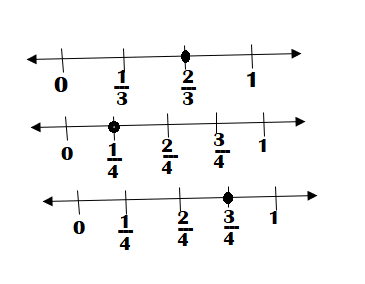
The greatest fraction is \(\frac{3}{4}\).
Maria used \(\frac{3}{4}\) cup of flour.
\(\frac{2}{3}\) > \(\frac{1}{4}\)
=> sugar > brown sugar
=> flour > sugar > brown sugar
\(\frac{3}{4}\) > \(\frac{2}{3}\) > \(\frac{1}{4}\)
Practice the Strategy
Ameer is making salsa using tomatoes, onions, and black beans. Use the clues below to find the amount of each ingredient he used.
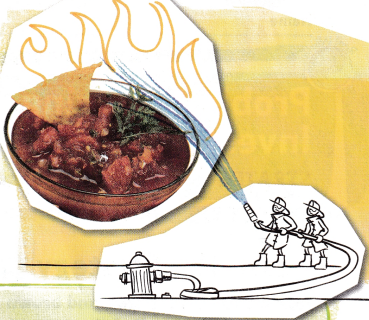
- The amounts are: \(\frac{1}{2}\) cup, \(\frac{3}{4}\) cup, and \(\frac{1}{3}\) cup.
- He is using more tomatoes than black beans and more black beans than onions.
1. Understand
What facts do you know?
What do you need to find?
2. Plan
3. Solve
4. Check
Does your answer make sense? Explain.
Answer:
Number of cups of tomatoes he used = \(\frac{3}{4}\)
Number of cups of black beans he used = \(\frac{1}{2}\)
Number of cups of onions he used = \(\frac{1}{3}\)
Yes, my answer makes sense because it fulfills all the rules given in the question.
Explanation:
The amounts are: \(\frac{1}{2}\) cup, \(\frac{3}{4}\) cup, and \(\frac{1}{3}\) cup.
Comparison:

He is using more tomatoes than black beans and more black beans than onions.
\(\frac{3}{4}\) cup > \(\frac{1}{2}\) cup > \(\frac{1}{3}\) cup.
Number of cups of tomatoes > Number of cups of black beans > Number of cups of onions
Apply the Strategy
Solve each problem by using logical reasoning.
Question 1.
Sophia is making a salad with tomatoes, cucumbers, and mozzarella cheese. Use the clues to find the amount of each ingredient.
- The amounts are \(\frac{3}{6}\) cup, \(\frac{2}{5}\) cup, and \(\frac{3}{4}\) cup.
- There is a less amount of tomatoes than cucumbers.
- There is a less amount of cheese than tomatoes.
Answer:
Number of cups of tomatoes she used = \(\frac{3}{4}\)
Number of cups of cheese she used = \(\frac{3}{6}\)
Number of cups of cucumbers she used = \(\frac{2}{5}\)
Explanation:
The amounts are \(\frac{3}{6}\) cup, \(\frac{2}{5}\) cup, and \(\frac{3}{4}\) cup.
Comparison:

\(\frac{3}{4}\) cup > \(\frac{3}{6}\) cup > \(\frac{2}{5}\) cup
There is a less amount of tomatoes than cucumbers.
There is a less amount of cheese than tomatoes.
=> tomatoes < cheese < cucumbers
Question 2.
Mason walked on Monday, Wednesday, and Friday. Use the clues to find how far he walked each day.
- The distances were \(\frac{6}{8}\) mile, \(\frac{1}{4}\) mile, and \(\frac{1}{6}\) mile.
- He did not walk the farthest on Monday.
- He walked less on Friday than Monday.
Answer:
Number of miles he ran on Wednesday = \(\frac{6}{8}\)
Number of miles he ran on Monday = \(\frac{6}{8}\)
Number of miles he ran on Friday = \(\frac{6}{8}\)
Explanation:
The distances were \(\frac{6}{8}\) mile, \(\frac{1}{4}\) mile, and \(\frac{1}{6}\) mile.
Comparison:
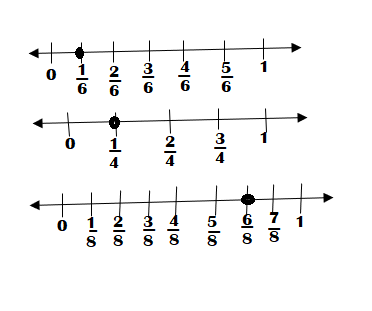
\(\frac{6}{8}\) mile > \(\frac{1}{4}\) mile > \(\frac{1}{6}\) mile.
He did not walk the farthest on Monday.
He walked less on Friday than Monday.
=> Wednesday > Monday > Friday
Question 3.
Mathematical PRACTICE Plan Your Solution Emma saw birds, fish, and bears at the zoo. One-third of the animals did not have feathers or fur. One-half of the animals have four legs. There were one-sixth of the animals left. What fraction of the animals were birds?
Answer:
Fraction of number of birds = One-sixth.
Explanation:
Emma saw birds, fish, and bears at the zoo.
Fraction of the animals did not have feathers or fur = One-third.
=> Fraction of number of Fishes = One-third.
Fraction of the animals have four legs = One-half.
=> Fraction of number of bears = One-half.
Fraction of the animals left = One-sixth .
=> Fraction of number of birds = One-sixth.
Review the Strategies
Use any strategy to solve each problem.
- Work backward.
- Make a table.
- Make a model.
- Look for a pattern.
Question 4.
Emil bought his mom a dozen roses. Some of the roses are shown below. The rest are white.

Of which color were there the most?
What fraction of the roses were that color? Write in simplest form.
Write an equivalent fraction.
Answer:
Fraction of flowers are white = \(\frac{1}{6}\)
Equivalent fraction of \(\frac{1}{6}\) = \(\frac{3}{18}\)
Explanation:
Total number of flowers Emil bought his mom = 12.
Number of flowers are yellow = 4.
Number of flowers are red = 6.
Number of flowers are white = Total number of flowers Emil bought his mom – (Number of flowers are yellow + Number of flowers are red)
= 12 – (6 + 4)
= 12 – 10
= 2.
Simplest form:
Fraction of flowers are white = Number of flowers are white ÷ Total number of flowers Emil bought his mom
= 2 ÷ 12
= 1 ÷ 6 or \(\frac{1}{6}\)
Equivalent fraction of \(\frac{1}{6}\):
\(\frac{1}{6}\) = \(\frac{1}{6}\) × \(\frac{3}{3}\) = \(\frac{3}{18}\)
Question 5.
Dirk ran eight-tenths of a mile at track practice. Leslie ran \(\frac{80}{100}\) of a mile. Who ran farther? Explain.
Answer:
Dirk and Leslie ran same distance.
Explanation:
Number of miles Dirk ran at track practice = eight-tenths or \(\frac{8}{10}\)
Number of miles Leslie ran at track practice = \(\frac{80}{100}\)
Simplest form:
\(\frac{8}{10}\) = \(\frac{8}{10}\) ÷ \(\frac{2}{2}\) = \(\frac{4}{5}\)
\(\frac{80}{100}\) = \(\frac{80}{100}\) ÷ \(\frac{10}{10}\) = \(\frac{8}{10}\)
÷ \(\frac{2}{2}\) = \(\frac{4}{5}\)
=> Both are same with distance they ran.
Question 6.
Mrs. Keys has 36 pens. Yesterday she had half that amount plus 2. How many pens did she have?
Answer:
Total number of pens Mrs. Keys has = 56.
Explanation:
Number of pens Mrs. Keys has = 36.
Yesterday she had half that amount plus 2.
=> Number of pens she had added yesterday = (36 half)+ 2 = (36 ÷ 2) + 2 = 18 + 2 = 20.
=> Total number of pens Mrs. Keys has = Number of pens Mrs. Keys has + Number of pens she had added yesterday
= 36 + 20
= 56.
Question 7.
Mathematical PRACTICE Draw a Conclusion There are bananas, pears, and peaches in a bag. One-eighth of the fruits are pears. One half are bananas. Are there more pears or bananas?
Answer:
=> Number of the fruits are bananas are more than number of the fruits are pears.
Explanation:
There are bananas, pears, and peaches in a bag.
Number of the fruits are pears = One-eighth = \(\frac{1}{8}\)
Number of the fruits are bananas = One half = \(\frac{1}{2}\)
Comparison:
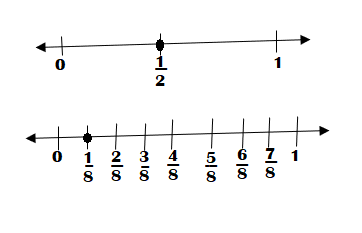
\(\frac{1}{8}\) < \(\frac{1}{2}\)
McGraw Hill My Math Grade 4 Chapter 8 Lesson 8 My Homework Answer Key
Problem Solving
Solve each problem by using logical reasoning.
Question 1.
Mathematical PRACTICE Stop and Reflect Ryan has his artwork displayed at the library, the mall, and the bank. Use the clues to find the fraction of his art that is displayed at each place.
- \(\frac{1}{4}\) of the art is at one location, \(\frac{1}{8}\) of the art is at the second location, and \(\frac{5}{8}\) of the art is at the third.
- There is more of Ryan’s art at the library than the mall.
- There is less of Ryan’s art at the bank than at the mall.
Answer:
Fraction of his art that is displayed at library = \(\frac{5}{8}\)
Fraction of his art that is displayed at bank = \(\frac{1}{4}\)
Fraction of his art that is displayed at mall = \(\frac{1}{8}\)Explanation:
\(\frac{1}{4}\) of the art is at one location.
\(\frac{1}{8}\) of the art is at the second location.
\(\frac{5}{8}\) of the art is at the third location.
Comparison:
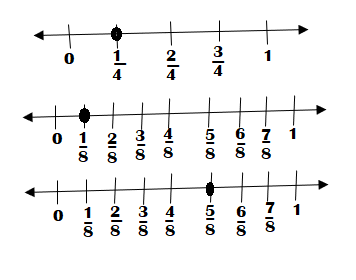
\(\frac{5}{8}\) > \(\frac{1}{4}\) > \(\frac{1}{8}\)
There is more of Ryan’s art at the library than the mall.
There is less of Ryan’s art at the bank than at the mall.
=> L > M < B
\(\frac{5}{8}\) > \(\frac{1}{8}\) < \(\frac{1}{4}\)
Question 2.
Benjamin made a fruit salad with strawberries, blueberries, and kiwi. Use the clues to find the amounts of each ingredient.
- The amounts were \(\frac{3}{4}\) cup, \(\frac{2}{8}\) cup, and \(\frac{1}{2}\) cup.
- Benjamin used more blueberries than strawberries.
- Benjamin used more strawberries than kiwi.
Answer:
Number of cups of blueberries Benjamin used = \(\frac{3}{4}\)
Number of cups of strawberries Benjamin used = \(\frac{1}{2}\)
Number of cups of kiwi Benjamin used = \(\frac{2}{8}\)
Explanation:
Benjamin made a fruit salad with strawberries, blueberries, and kiwi.
The amounts were \(\frac{3}{4}\) cup, \(\frac{2}{8}\) cup, and \(\frac{1}{2}\) cup.
Comparison:

\(\frac{3}{4}\) cup > \(\frac{1}{2}\) cup > \(\frac{2}{8}\) cup.
Benjamin used more blueberries than strawberries.
Benjamin used more strawberries than kiwi.
=> b > s > k
Question 3.
Layla wrote a report about insects. She listed the lengths of tiger beetles, carpenter ants, and aphids. The lengths were \(\frac{1}{2}\) inch, \(\frac{5}{8}\) inch, and \(\frac{1}{8}\) inch. A tiger beetle is bigger than a carpenter ant. A carpenter ant is bigger than an aphid. List the sizes of each insect.
Answer:
Length of tiger beetles = \(\frac{5}{8}\) inch.
Length of carpenter ants = \(\frac{1}{2}\) inch.
Length of an aphids = \(\frac{1}{8}\) inch.
Explanation:
She listed the lengths of tiger beetles, carpenter ants, and an aphids.
The lengths were \(\frac{1}{2}\) inch, \(\frac{5}{8}\) inch, and \(\frac{1}{8}\) inch.
Comparison:
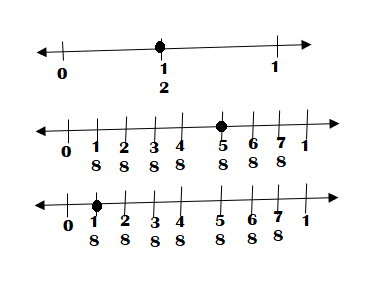
\(\frac{5}{8}\) inch > \(\frac{1}{2}\) inch and \(\frac{1}{8}\) inch.
A tiger beetle is bigger than a carpenter ant.
A carpenter ant is bigger than an aphid.
=> tiger beetle > carpenter ant > aphid